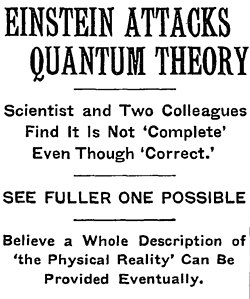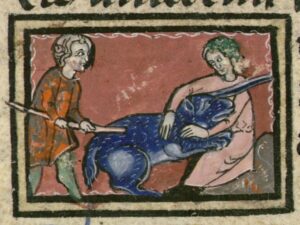After escaping the Nazis by minutes and then getting smuggled through spy-infested Stockholm, the bomb bay of a British fighter jet might have been a relief to physicist Niels Bohr. His approach to quantum mechanics held unsettling implications about the meaning of death, and now he had nearly escaped its shadow.
The Nazis had invaded his native Copenhagen in 1940. That was three years before the father of quantum mechanics found himself strapped to the felt-lined insides of a de Havilland Mosquito with only an ill-fitting helmet, a reading light, an oxygen mask, and a thin blanket for comfort. Bohr abhorred the Nazis, but had resisted every previous attempt by the British government to evacuate him. He had work to do in Copenhagen. He was busy shuffling Jewish scholars through his Institute of Theoretical Physics. During their visits, they were all offered very prestigious, very convenient fellowships to leave the Axis territories immediately.
Bohr did not worry as much about himself as he did about others. His mother might have been Jewish, but he didn’t practice Judaism. Surely if he didn’t consider himself Jewish, neither would the Nazis.
Then, in 1943, a tip-off from a Gestapo worker led to Bohr’s narrow escape on a boat to Stockholm. And now the fighter jet, and a helmet that didn’t fit right. The rip would last only two-and-a-half hours as they flew over the contested airways to England, where Bohr would finally be safe. Perhaps he felt as though the danger of his last week was finally over.
Blackout
Over the helmet’s intercom, the pilot advised him to put on his oxygen mask, as the Mosquito was nearing 7,000m. But Bohr didn’t hear the announcement through his badly fitting helmet. As the Mosquito climbed, Niels Bohr, whose discoveries in physics would lead to both quantum computing and the atom bomb, lost consciousness and drifted toward death.

The de Havilland Mosquito made risky flights over contested airspace by flying higher than Nazi planes. Photo: Wikimedia Commons
Nearly a decade before, Niels Bohr’s colleague Albert Einstein had co-authored a paper contending that the emerging theory of quantum mechanics was incomplete.
Einstein and Bohr had been tossing the matter back and forth for years. While Bohr was far from the only contributor to quantum theory, he was its earliest and most prominent advocate. Einstein agreed that quantum mechanics appeared to work, but he thought Bohr’s interpretation of it made no sense at all.
The Copenhagen interpretation
It was called the Copenhagen interpretation, after Bohr’s beloved city. If you have taken a physics class that covers quantum mechanics, this is almost certainly how you learned the subject. Bohr developed the Copenhagen interpretation in conjunction with Werner Heisenberg (who would go on to lead the Nazi effort to build an atom bomb) and Max Born (who would be among the first wave of Jewish academics to flee Germany in 1933).

The 1927 Solvay conference brought together many of the greatest minds in physics over heated debates in quantum mechanics. Albert Einstein sits center front, while Niels Bohr is on the far right in the middle row. Photo: Wikimedia Commons
Copenhagen posits that at the very small scale, such as individual atoms or electrons, the universe exists in a permanent juxtaposition of different possibilities. The exact position of a particle in a box, for instance, is not defined by default. It is not merely that we don’t know where a particle is. Instead, the particle has no actual location, merely probabilities of being in different locations, until we try to observe where it actually is. Then all those probabilities coalesce into an actuality: The particle is here, not there, and moreover, it will stay there even when we stop observing. We can go make a cup of tea, do some dishes, and when we come back, it will be exactly where we left it. If we shake the box around, though, the position of the particle goes back to a fluffy cloud of probabilities.
For obvious reasons, this upset a lot of people. It agreed with experiments, and the math made sense, but nothing else did. It had some pretty bizarre implications regarding how events exist in space, too, which Einstein derided with the ever-quotable line, “spooky action at a distance.”
Schrodinger’s cat
When Einstein and two co-authors published their famous rebuttal of the Copenhagen interpretation in 1935, fellow Copenhagen critic Erwin Schrodinger wrote to him in support. To illustrate how ridiculous the Copenhagen interpretation was, Schrodinger described a hypothetical scenario in which the fate of a cat in a box depended on whether or not a particular quantum process (in this case, the nuclear decay of an atom) had occurred. If the atom decays, a mechanism in the box releases poison, killing the cat. If the atom doesn’t decay, the cat is fine. Schrodinger wrote how in this quantum system, the cat is alive and dead at the same time, “mixed or spread out in equal parts.”
Ridiculous though it was, the Copenhagen interpretation agreed. If there exists some quantum process in the brain that makes the difference between life and death during oxygen deprivation, then for two-and-a-half hours, the bomb bay of the de Havilland Mosquito contained both the living (but unconscious) and the dead bodies of Niels Bohr, father of quantum mechanics.

One of Einstein’s collaborators on his anti-Copenhagen paper leaked it to the popular press. Reportedly, Einstein never spoke to him again. Photo: Wikimedia Commons
The many-worlds theory
For such an odd theory of the universe, the Copenhagen interpretation has surprising tenacity. It has vanquished every other approach to quantum mechanics in popularity if not in evidence. Why?
Part of it is that, as the first explanation, it has priority. Part of it has to do with the fact that its rivals are even more mathematically complicated (pilot wave theory), spiritually troubling (conscious measurement theory), or far out there (many-worlds).
In the pilot wave theory, the mathematics that predict probabilities in the Copenhagen interpretation instead describe a background field along which particles travel, much like an electric field. Particles have a real position, the cat is either alive or dead, but if we try to find out specifics, then we disturb the system. We will never know if the cat was alive just before we opened the box.
Conscious measurement theory runs far in the opposite direction. Possibility only collapses into reality when it interacts with a conscious observer. It is not enough to be seen on camera, someone has to be controlling the camera and attempting to process its information. The nature of death is about the only thing that isn’t unsettling about this theory: A conscious observer collapses the probabilities, so the cat (or Niels Bohr) is either alive or dead, not both.
When everywhere becomes somewhere
But as bizarre as the Copenhagen interpretation of death might be, the many-worlds theory of quantum mechanics rivals it. It began with Hugh Everett III, a PhD student studying under John Wheeler, one of Niels Bohr’s former students. Everett grew troubled by the Copenhagen interpretation, which seemed unnecessarily complicated. Why mess around with this business of something that was everywhere suddenly being somewhere when observed? After all, that implies the universe rearranges itself instantaneously. If nothing moves faster than the speed of light, how is that possible?
Easy, said Everett. It isn’t. Nothing rearranges itself. Instead, the different probabilities predicted by quantum mechanics don’t relate to whether the particle is actually at point A rather than B. Rather, they describe the chance that we are in a particular universe where the particle is at A instead of B. When we open the box, all we do is check which universe we are in.

According to many-worlds proponents, there are at least 10^100 different parallel universes. That’s 1 followed by 100 zeroes. Photo: Veritasium
This all sounds rather abstract. Nonetheless, Everett’s PhD advisor, John Wheeler, recognized that in many ways, it’s the simplest interpretation of the probability-based math required by quantum experiments. Wheeler encouraged Everett to publish it as his thesis, including a mathematical formulation for branching universes.
In 1959, Wheeler made the mistake of sending his protégé off to Copenhagen to meet the grandmasters of quantum mechanics. The meeting did not go well. Everett later described it as “hell” and “doomed from the start.” One of the physicists he met, Leon Rosenfeld, detailed his impression of Everett in a letter: “He was indescribably stupid and could not understand the simplest things in quantum mechanics.”
Everett promptly left academia for defense work.
Quantum immortality
Many-worlds lay dormant for a decade. Then, in 1970, a small circle of physicists rediscovered it and coaxed Everett into elucidating his ideas. Everett never returned fully to physics, but he stayed engaged with the small community of many-worlds enthusiasts.
One of the oddest features of many-worlds is the nature of death. In the Copenhagen interpretation, the probability of Schrodinger’s cat being alive when we open the box is vanishingly small, the longer the experiment goes on. So small, in fact, that it approaches zero very quickly. In many-worlds, however, there is always a universe where one version of the cat survives.
This is very nice for the surviving cat in that just-right universe and not at all nice for the different versions of it that died. Hugh Everett had a solution to this, although even he did not dare publish it. Privately, he believed that his consciousness would always stay in the universe in which it continued to exist.
Everett died of a heart attack in 1982. He was 51 years old. His daughter committed suicide fourteen years later and wrote in her last letter that she was going to join her father in a parallel universe.

Recently, physicist Max Tegmark revived discussion of quantum immortality and its logical extrapolation, quantum suicide, in his book Our Mathematical Universe. Photo: Jeremie Harris
The fate of Niels Bohr
When the British army opened the bomb bay of the Mosquito, they found Niels Bohr unconscious but alive. Death by oxygen deprivation is not truly a quantum mechanical process, so our analogy notwithstanding, his survival says nothing about quantum mechanics.
Bohr went on to participate in the British arm of the Manhattan Project until his morals got in the way. He believed that the atom bomb would alter the world forever, and to develop it in secret was unforgivable. Hinting at the project in letters to Russian colleagues, he found an ally in Robert Oppenheimer. With Oppenheimer’s help, Bohr met with Franklin D. Roosevelt, whom he tried to convince to make the project public. Roosevelt declined. By all accounts, though, he was more sympathetic to Bohr than Winston Churchill, who wrote, “It seems to me Bohr ought to be confined or at any rate made to see that he is very near the edge of mortal crimes.”
Churchill kept Bohr under close watch in England. Not until the United States bombed Hiroshima and Nagasaki was Bohr finally permitted to return to his native Copenhagen, where he dedicated much of the rest of his career to nuclear non-proliferation. He passed away in 1962, three years after meeting with a hot-headed young physicist named Hugh Everett III, who believed neither would ever truly die.






